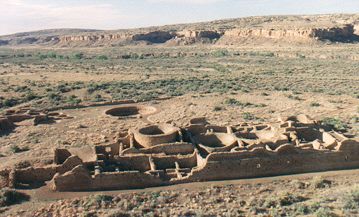
Chetro Ketl
The Anasazi Pueblos

Chetro Ketl
As large as two city blocks, Chetro Ketl is one of a dozen large pueblos within a twenty mile stretch along Chaco Wash. Constructed in 15 stages over 100 years, it consists of approximately 50,000,000 pieces of sandstone, each individually cut and dressed to fit. Altogether the Park contains over 400 Anasazi ruins, including 12 major sites. Excavations at the Great Houses have yielded a wealth of ornamental artifacts. The quality exhibited by Anasazi masonry in Chaco is the finest in the southwest. The Great Kiva in the distance is a little over 60 ft. wide. In the grassy area 100 feet to the west (right), another great kiva was excavated, then backfilled. On the cliff wall across the canyon, a set of wide steps was cut into the sandstone. These led to a stone bordered road which ran straight toward Tsin Kletzin on the high ground of South Mesa (to the right) and beyond.As many as seven roads radiated out of Chaco, and all ran straight regardless of obstacles, 26 to 40 feet wide wherever the topography isn't a consideration , bordered by berms of soil and rock or rows of large boulders. Roadbeds were excavated below the surface in areas of uneven topography. Huge ramps and scaffolds were erected to facilitate movement into and out of the canyon. Over 200 miles of these straight road (w/ dog leg turns) have been documented out of potentially 1500, with connections into Arizona, Colorado and Utah. The Anasazi had neither the wheel nor beasts of burden, so these roads were not built for business or casual use. Very few fire pits have been found along them, indicating they were not commonly used for commerce and camping.
Some theorize that Chaco Canyon was a Central Place, the ceremonial nexus for the outlying communites and that the roads were basically ornaments of the Great Houses. Dozens of small towns lay along the roads, sixty miles to the north and sixty miles south. Construction of the roads required an enormous amount of labor and social cooperation during a period when the people who lived here could hardly afford such an undertaking. Several mesa top signal stations have been located along the roads which would have allowed line of sight signals over a great distance by fire, smoke or reflected light. Chaco was very likely a center of some kind, very possibly a sacred meeting place where the tribes would gather on special occasions for ceremonies, rituals, dances, to renew old alliances and to transmit the ancient stories and songs.
The Navajo, latecomers to the area, regard the roads as evil and dark and explain their origin as the places where legendary figures sought refuge from Big Monster. But to the Anasazi, the straight road signified the spiritual path, the means of direct return to the Heart, the way of Life, just as the rays of the sun always take a straight course. Through the roads, fundamental spiritual ideas were ceremonially re-enacted physically on a periodic basis, instilling the wisdom of the ancestors into every member of the tribe from their earliest years. The end of the pilgrimage began with an emergence back into the world on a straight course.
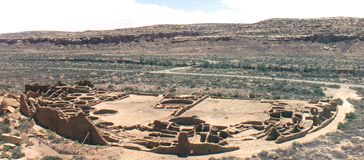
The ruins of Pueblo Bonito cover three acres, the largest single prehistoric Indian building at the time of its construction, 1030-1079 AD. The rear wall still rises four stories high in places. Although there is room for a thousand people, it seems that no more than 600 lived in Pueblo Bonito at any given time. 37 kivas have been identified at this site. The great kiva near the center is over 45 feet in diameter at the floor. Evidence of an extensive Pre-columbian trade network established by 1030 comes from Pueblo Bonito in the form of copper bells, marine shells, parrots and macaws, all of which were carried from the south. The Indians extracted a valuable blue stone, Turquoise, from mines around Cerillos, fashioned some of it into jewelry and traded it for Mexican goods.There have not been many bodies found at Chaco so there is some speculation about how they disposed of their dead. Although some theorize that the Anasazi were very egalitarian, there is also some evidence of status in the burials found here. Two men were found buried in a subfloor of a room in Pueblo Bonito, along with thousands of artifacts. Were they part of an elite class who controlled the turquoise trade and had amassed capital so that they were effectively the regional bankers and investors? Were they part of a religious or political hierarchy?
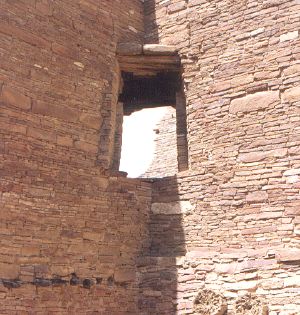
During the morning of the winter solstice, the rays of the rising sun shine through this second story window in Pueblo Bonito and strike the opposite corner of the room behind it. Although the window was within the building, it is very likely that there was a small hole in the outer wall which would allow the light to pass through. Many astronomically significant window and building alignments like this are found in Anasazi architecture. Notice the beams in the lower wall which supported the second floor. These had to be carried from the Chuska mountains, over 45 miles to the west. An estimated 215,000 logs were felled to construct the Great Houses. The Chaco settlement flourished for 150 years. Around 1130, a series of severe droughts occured which were to last half a century. The turquoise market alone could not sustain everyone and slowly, the exodus began.
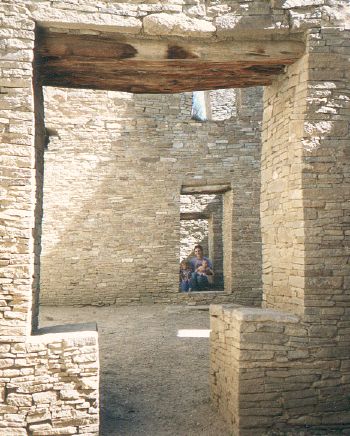
Woven mats may have been hung over these T-shaped doorways,
offering a little privacy as well as keeping heat in during winter and
keeping the heat out during the summer
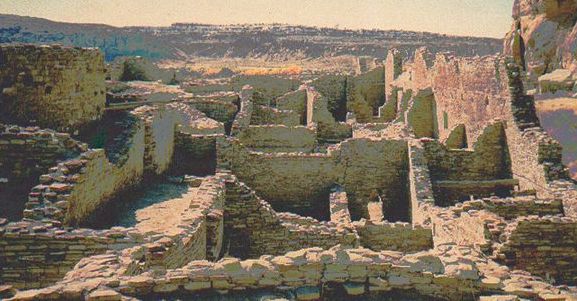
Chetro Ketl
No coming together can last forever. It will always end in separation. We are like inhabitants of different places gathering in thousands and even tens of thousands for a big market or an important religious festival, only to part again as each returns home. Whatever affectionate relationships we now enjoy - teachers and disciples, masters and servants, patrons and their protégés, spiritual comrades, brothers and sisters, husbands and wives - there is no way we can avoid being separated in the end. We cannot even be sure that death or some other terrible event might not suddenly part us right now. Since spiritual companions, couples and so forth might be split up unexpectedly at any moment, we had better avoid anger and quarrels, harsh words and fighting. We never know how long we might be together, so we should make up our minds to be caring and affectionate for the short while that we have left.
-Patrul Rinpoche
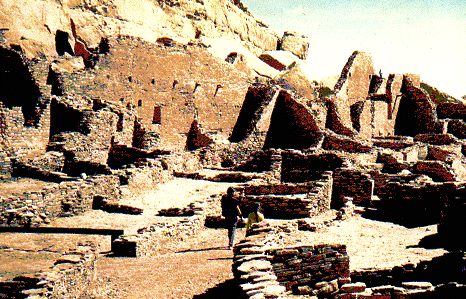
Pueblo Bonito
turtle hill ©2000